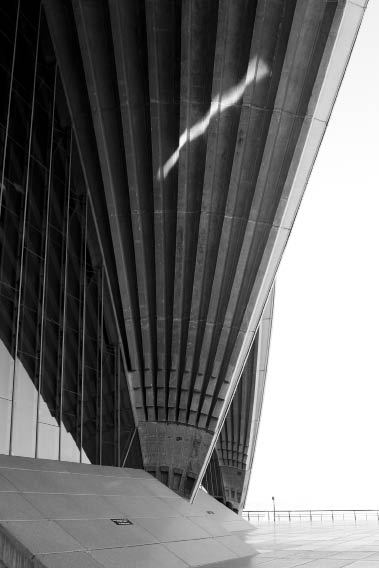You are celebrated as the architect of one of the most famous buildings in the world, now in your late eighties and living quietly in your home outside Copenhagen. One day a beautiful blonde German girl knocks on your door. She is clutching a folder of her photographs of the extraordinary structure on the other side of the world which, following a dispute in 1965 with a new Australian Government, you have never seen completed. For her, that architectural work was love at first sight. For you, her images are a love letter that confirms the enduring greatness of your conception. It is happiness on both sides, and its fruit the publication of this hauntingly beautiful book.
Few modern buildings can have been more photographed than the Opera House on Geelong Point in Sydney Harbour. But Katarina Stübe’s obsession with its towering, sail-like shells has sought out perspectives, angles, points of view that run against every clichéd image and restore to the building the wonderous strangeness of Jørn Utzon’s 1957 prize-winning conception.
Therein also reside problems of design, construction and functionality, many of which persist to this day. The textual commentary by Utzon’s son, Jan, himself an architect and intimately involved with the on-going development of the building, owns up to the problems without probing them too uncomfortably. One of the most taxing of these was how Utzon’s vision was actually going to be built. The constructional design was handed over to Ove Arup in London, where in the early 1960s, as a very junior engineer, I myself toiled over a drawing board on the project. Calculation of the stresses in the concrete shells was proving intractable as Utzon had wanted their curving surfaces to be of a very complex form.
My recollection, doubtless fallible, was that it was a Chinese mathematician at Arup’s who discovered that if the shapes were changed to spherical sections (think pieces of the skin of an orange), the visual discrepancy would be insignificant and the calculations could then be done — and that this was accepted by Utzon. His son’s narrative now suggests that it was Utzon himself who came up with the spherical sections. I’ve no cause to doubt Jan Utzon’s version, though I do feel he could have given a touch more credit to the major role played by Arup’s and the contractors in turning the dream into reinforced concrete.
But then this whole book is a homage that does not allow the intrusion of too much reality. Stübe’s eye is bewitched by the sculptural forms of the building so that her camera captures them as abstract ideality. In these days of digital manipulation, you begin to wonder about the artistic perfection of the predominantly grey and uniform skies. And how did Stübe manage to clear virtually every trace of humanity from the site before clicking her shutter? You are almost shocked to come across an image of Jan Utzon posing as a tiny figure at the base of one of the soaring arches.
No question that these are wondrously beautiful photographs, as alive to structural detail as to the impact of the soaring forms and the musical rhythms of their curvature. The element of Mayan inspiration in the design is emphasised in shots which show the tiers of steps surmounted by the brooding, almost threatening, presence of the arches formed by the shells.
Utzon was not welcomed back to the great project until 1999. By then he was too frail to travel and had to ask his son to take over everything at the Australian end — most especially the sorting out of the still problematic interior. It’s no surprise to learn that Jørn Utzon, who died in 2008, expressed himself thrilled and delighted by Stübe’s images. They surely restore and extol his magnificent fantasy, his dream that all along was perhaps never so much of an opera house as of an astonishing sculpture.






Comments